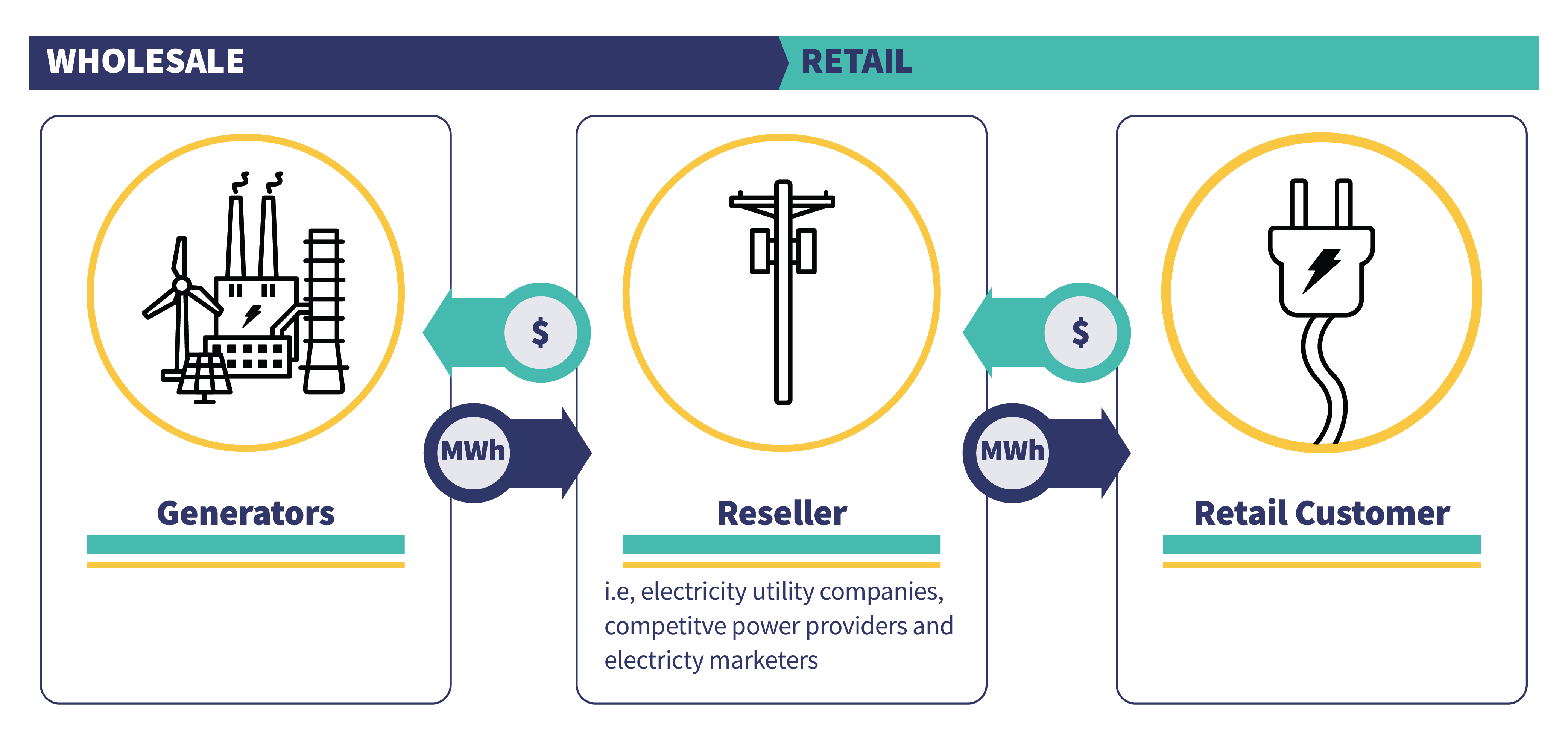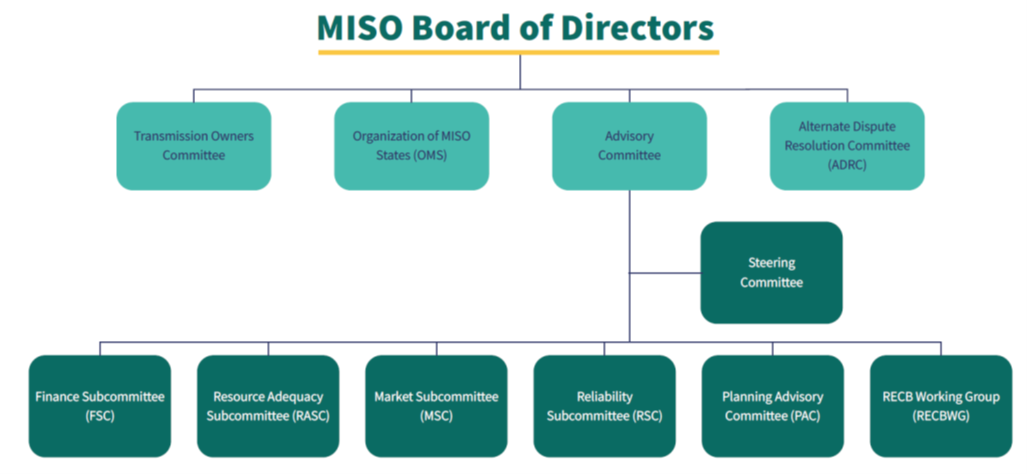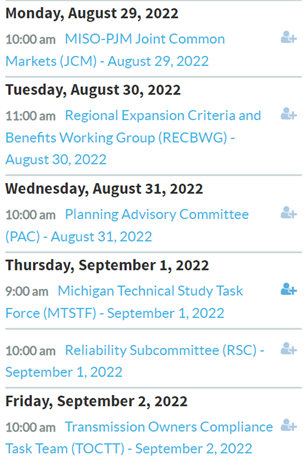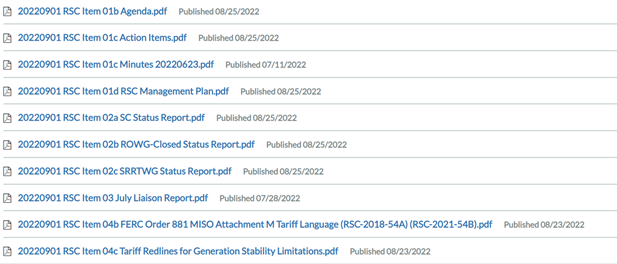Q. What is MISO and what does it do?
A. The Midcontinent Independent System Operator (MISO) operates the electric transmission system or “grid” in portions of 15 states in the Midwest and the South, plus the Canadian province of Manitoba. MISO, which began market operations in 2005, is headquartered in Carmel, Indiana, and has regional offices in Eagan, Minnesota, and Little Rock, Arkansas. In the U.S., MISO spans all or part of the following 15 U.S. states: Montana, North Dakota, South Dakota, Minnesota, Iowa, Wisconsin, Michigan, Indiana, Illinois, Missouri, Kentucky, Arkansas, Mississippi, Louisiana, and Texas. In the map below, blue shaded areas include the MISO North region, green shaded areas are in the MISO Central region, and the orange shaded area is the MISO South region. MISO added the South region, including parts of Arkansas, Mississippi, Louisiana, Texas, when the Entergy utility company joined MISO in 2013. MISO covers the largest geographical range of any independent system operator (ISO) in the U.S.
As the ISO of the electric grid in this region, MISO manages the flow of electricity across the high-voltage, long-distance power lines. To do so, MISO develops rules so that the wholesale electricity transmission system operates reliably and safely. MISO has described this as being like the “air traffic controller” for the grid in its territory, meaning that MISO seeks to resolve power congestion (traffic) issues in real-time through its control room and tries to anticipate and avoid emergencies that could lead to the loss of power. MISO has also developed various electricity markets, including electric energy markets, in which buyers and sellers bid to purchase or offer to sell wholesale electricity.
MISO is one of seven ISOs or RTOs (regional transmission organizations) that the Federal Energy Regulatory Commission (FERC) has helped to develop and oversee since the late 1990s in various parts of the country. The aim of these RTO/ISOs is to ensure non-discriminatory access to the grid, so that sellers and buyers of wholesale electricity are able to connect with ease and efficiency and achieve competitive, fair, market-based prices reflecting supply and demand. Another key part of MISO’s activities is the day-to-day business of running the wholesale electricity markets in its territory, which is an intricate operation that relies on complex market rules. MISO develops these market rules based in part on input from stakeholders (representatives from different groups, such as power suppliers and marketers, consumer organizations, utilities, and others) and rulings by FERC. FERC has regulatory oversight over MISO’s U.S. activities.
Q. What does it mean when you refer to the “wholesale electricity transmission system” or the “bulk power system?”
A. MISO, under FERC jurisdiction, operates high-voltage transmission lines that move wholesale power throughout its territory, often across significant distances. By contrast, power lines that deliver electricity to retail customers on electric utility poles are considered to be local “distribution,” and are generally subject to state or local regulation and jurisdiction.
One key distinction between transmission and distribution is voltage: in general, local distribution lines are lower voltage – 100 kilovolts or less – and high-voltage transmission lines are everything above that. MISO operates (and FERC regulates) the high-voltage lines and approves the rates for the power that flows on those lines. These activities are often referred to collectively as the “bulk power system.”
The following diagram illustrates how electricity travels, including MISO’s operation of transmission lines subject to FERC’s jurisdiction[i]:
You have probably seen tall poles carrying electricity along a strip of land that look like the tall metallic pole in the middle of the above picture; this is an example of high voltage electricity transmission managed by MISO in its territory.
Q. Does MISO own the electric transmission that it operates?
A. No – MISO operates those lines but does not own them. Utilities that choose to join MISO continue to own the transmission infrastructure (lines and poles and other equipment) but hand over operational control to MISO. MISO is called an “independent system operator” or “ISO” because it has independent authority, overseen by FERC, to operate the transmission lines owned by the utilities. MISO has also been designated by FERC as the “regional transmission organization” or “RTO” for its territory.
Utilities that join and turn over functional control of their transmission assets to MISO are referred to as Transmission Owning Members or “TOs.”[ii] In return, such utilities receive “just and reasonable rates” through MISO when those facilities are used, with the payments coming from the users or allocated in accordance with MISO rules.
Q. What does “wholesale electricity” mean, and why does MISO operate a market for it?
A. To understand wholesale sales of electricity, consider the graphic below. In the graphic, the power generation plant (Generator) sells electricity to an electric utility or other company that resells power (Reseller), who in turn intends to resell that electricity to homes and businesses (retail customer). The sale from Generator to Reseller is a wholesale sale of electricity and FERC almost always has jurisdiction over the rates charged for that sale. Wholesale sales in MISO’s U.S. territory are in interstate commerce because of the interconnected grid across numerous states.
Wholesale sales of electricity can be contrasted with “retail” sales of electricity to customers. When your local electric utility sells you electricity for use in your home or business, that is a retail sale, not wholesale, and is not under the jurisdiction of FERC. In MISO and the other RTO/ISOs, retail electric service is provided to customers by your local utility company. The rates those retail utilities charge are regulated by a state utility regulatory commission (for privately owned utilities), by a city (for municipal utilities), or by a cooperative board (for rural electric cooperatives).
If you have concerns about your retail electric bill or service, the right place to address those concerns is with your utility, the applicable local regulatory authority, or your state public utility commission - not MISO or FERC.
Q. Why are MISO processes and markets important?
A. Although MISO is not directly involved with your electric bill or the electric service to your home or business (as noted above, those tasks are met by your utility), MISO makes decisions that can have a major impact on the price and reliability of electricity in your area as well as on the implementation of key state and federal energy and environmental policies.
For example, it is MISO’s responsibility to balance demand for electricity with the available supply through operation of its wholesale electricity market. Electric grids must run in balance, i.e., the electricity coming onto the grid must equal the electricity being used, at all times. MISO achieves this essential balancing function through two inter-related markets that it administers: the real-time energy market and the day-ahead energy market.
In the “real-time” energy market, MISO every five minutes forecasts electric demand and directs the least expensive set of power resources that bid into the market to provide electricity to meet demand, considering factors such as the capacity of the transmission wires, power plant disruptions or outages, and natural disasters and extreme weather conditions. MISO dispatches electric resources and allocates payments based on immediate, “real-time” needs through the real-time market.
Meanwhile, in the “day-ahead” energy market, MISO conducts day-ahead forecasting of demand for electricity, accepting next-day electricity bids from market participants in order to meet anticipated demand with some advance planning. Utilities look to the MISO day-ahead energy market to reduce their pricing risks, as the prices in the real-time market tend to be more volatile based on circumstances such as sudden changes in weather or a power plant outage.
The day-ahead market allows MISO to plan ahead to manage transmission congestion that may arise from prevailing conditions, especially weather. Congestion is when a portion of the transmission grid becomes overloaded with electric power. Such overloading can cause a wire to overheat, stretch and, in an extreme case, touch other wires, structures, or vegetation, which can create a hazard or an outage. To avoid this, MISO forecasts demand and designs its market rules to choose the lowest-cost resources, subject to any anticipated congestion constraints on the transmission system. This might mean that a power plant or other supply resource located close to a high electric use area (for example, a large town or city) could be called upon to produce electricity on a certain day even if it is not the lowest-cost resource.
MISO has other specialized products and services that it procures through its “ancillary services” market to ensure that there are adequate electric reserves to maintain reliability and sufficient voltage to enable the grid to operate. An example of an ancillary service is the ability of a power plant to start up on very short notice, called “cold start” or “black start” capability, in order to meet an unanticipated or emergency need for power.
Q. How is MISO governed?
A. MISO has an executive team that is overseen by an independent Board of Directors (Board) consisting of ten members. Each member of the Board serves a three-year term and must meet specific qualifications designed to ensure an independent and qualified Board.[iii] The MISO Chief Executive Officer is one director, and the other nine are elected by MISO members. The terms of directors are staggered to provide continuity in Board membership. The MISO Board has six standing committees: Audit & Finance, Corporate Governance & Strategic Planning, Human Resources, Markets, System Planning, and Technology.
Q. What is MISO’s stakeholder process?
A. Stakeholders play an important role in MISO’s operations. As is the case with other RTO/ISOs, MISO stakeholder processes can lead to the development and revision of MISO’s market rules.
MISO’s website contains a Stakeholder Engagement Page[iv] and a short introductory video, entitled “Who is a MISO Stakeholder.” This video explains different types of stakeholders and makes it clear that any individual or group interested in MISO issues is considered a “stakeholder.” MISO stakeholder meetings provide opportunities for the public to attend and participate, but voting is restricted to MISO members and certain non-members pursuant to MISO rules.
MISO has various stakeholder committees (not to be confused with the MISO Board committees described above) that enable stakeholders to consider issues and propose changes to MISO market rules. The key committee where stakeholders provide input and recommendations to the MISO Board is the Advisory Committee. The Advisory Committee uses a weighted voting process and if it recommends a particular action by favorable vote, that recommendation goes to the MISO Board.
Six technical committees report up to the Advisory Committee: Finance Subcommittee, Resource Adequacy Subcommittee, Market Subcommittee, Reliability Subcommittee, Planning Advisory Committee, and Regional Expansion Criteria and Benefits Working Group. There is also a Steering Committee, which steers issues to one or more of the technical committees before they go up to the Advisory Committee. In these various committees, stakeholders develop issues for discussion and, if proponents secure sufficient support, they vote to move them forward. Final rules are detailed in proposed tariffs that are presented to FERC for approval.
Here is a graphic depicting the MISO Board and Committee Structure:
MISO stakeholders are divided into 11 sectors, which are then divided into member and non-member sectors. Member sectors include: Transmission-Dependent Utilities, Independent Power Producers, Power Marketers, Eligible End-Use Customers, Coordinating Members, Transmission Developers, and Transmission Owners. Non-member sectors include: State Regulatory Authorities, Public Consumer Advocates, Environmental, and Affiliate.
Q. What is the Organization of MISO States and what is its role?
A. The Organization of MISO States (OMS) is the umbrella group of the State Regulatory Authorities (i.e., the state-level regulators of retail customers’ rates) in the MISO region. OMS was “established to represent the collective interests of state and local utility regulators in the [MISO] region and facilitate informed and efficient participation in related issues.”[v] OMS participates in MISO’s stakeholder process, provides recommendations to the MISO Board concerning policies that impact state interests, and intervenes in FERC proceedings that address all aspects of MISO’s activities. The OMS Board of Directors consists of one designated commissioner from each of the 15 state regulatory authorities within MISO’s footprint, plus a representative from the City of New Orleans and from the Province of Manitoba. In addition to representing the states in the advisory committee, OMS has a special role in MISO’s transmission planning and transmission cost allocation under MISO’s governing rules (tariffs).
Q. How can people interested in MISO issues participate and attend public meetings?
A. MISO Board meetings are held at least quarterly and are open to the public, as are meetings of the various Committees of the Board. All these meetings allow for remote participation by dial-in or WebEx.[vi] Notice of Board meetings, agendas, and copies of all meeting materials are posted on MISO’s website.[vii] Interested members of the public can provide oral and written comments during the open portion of the Board meeting. The Board and its committees are authorized to hold executive sessions that are closed to the public as necessary to safeguard confidentiality of sensitive information.[viii]
MISO Board decisions are made by a majority vote of Board members, so long as a quorum is present.
In addition, most stakeholder committee meetings are open to the public, and WebEx and dial-in options are available for registered participants. Agenda and meeting details are posted in the stakeholder engagement calendar on the MISO website (see endnote viii). Members of the public do not vote in these meetings, as that is reserved for MISO members and other stakeholders such as state regulators, consumer advocate organizations, and certain environmental advocacy organizations that have voting rights.
Members of the public may raise issues to the Steering Committee, who will in turn steer the issue to one or more of the technical committees for consideration.
Q. How can one stay informed as to MISO meetings, events, and activities?
A. The MISO Stakeholder Engagement page is an excellent resource.[ix] It includes links for subscribing to mailing lists and information about how to log in to WebEx to facilitate remote participation. As noted above, the calendar entries include agendas and meeting materials as soon as they become available. The MISO website also contains market reports, including those of the Independent Market Monitor, market data, white papers on various topics, press releases, seasonal outlook reports for upcoming summer and winter seasons, and more.
The stakeholder engagement link and other key links are right on the front of MISO’s website, MISOenergy.org:
Here is a sample of the types of meetings that you will see on the calendar on the website:
As an example of the significant detail you can access in advance of the meeting, here is a list of the materials for the 9/1/22 Reliability Subcommittee meeting approximately one week in advance:
So, as you can see, if you were interested in attending that meeting, you would be able to access the agenda, the minutes of the last meeting, and many other details.
Q. How can a person interested in MISO matters impact the MISO decision-making processes?
A. As discussed above, MISO Board meetings (including committees of the Board) and MISO stakeholder committee meetings provide opportunities for the public to attend and participate.
As with all RTO/ISOs, the issues before the MISO Board and stakeholder committees are often quite complex and detailed, written in technical language, and in some cases reflect over twenty years of history and negotiation. Thus, there may be value in trying to coordinate your efforts with organizations or individuals who share your perspectives and have familiarity with MISO processes. Whatever your interests are, you are very likely to find that there are like-minded stakeholders that are already participating actively and would appreciate your input and support, whether your issue is rates, environmental questions, reliability, or something else. Even experienced MISO stakeholders often try to build coalitions to accomplish goals through the committee process and at the MISO Board level rather than trying to “go it alone.”
You can also seek to connect with your state public utility commission[x] to learn more about its positions in MISO matters. As noted above, your state commission would be a member of OMS and has a key role in MISO committees and processes. You can also reach your state consumer advocate’s office[xi] to coordinate and learn about its stances on MISO matters. Consumer advocate organizations also frequently participate and vote in MISO committee meetings.
Q. How do I learn more about MISO?
A. Again, the MISO website and its Stakeholder Engagement page are an excellent place to start. The Stakeholder Engagement page also links to MISO’s Customer training page,[xii] which offers free online trainings that provide an in-depth look at MISO’s market operations and business practices.
FERC also has resources that can help you gain more background on the electric industry generally, with some specifics on MISO, in its 2020 Energy Primer.[xiii] If you would like more information about MISO, please contact the Office of Public Participation (OPP) for information as well as help with navigating FERC’s web resources. OPP may be reached by e-mail at [email protected] or by phone at (202) 502-6595.
[i] Graphic developed by the National Energy Education Development Project, Electricity, at 56 (2017), http://www.need.org/Files/curriculum/infobook/Elec1S.pdf.
[ii] A list of MISO Transmission Owners and other stakeholders is available here: https://cdn.misoenergy.org/Stakeholder%20Group%20Participation95902.pdf
[vi] Interested members of the public can subscribe to receive meeting lists, updates and remote registration to public meetings on MISO’s website at https://www.misoenergy.org/account/Register .
[vii] The dates of the meetings are posted here, along with other Board information: https://www.misoenergy.org/stakeholder-engagement/committees/board-of-directors-bod/. You can also go to MISO’s Stakeholder Engagement Calendar to find the agenda and materials for meetings, available here: https://www.misoenergy.org/stakeholder-engagement/
[viii] See “Governance Structure and Practices in the FERC-Jurisdictional ISOs/RTOS,” prepared by Exeter Associates, Inc. for NESCOE, located at http://nescoe.com/wp-content/uploads/2021/02/ISO-RTOGovernanceStructureandPractices_19Feb2021.pdf
[ix] https://www.misoenergy.org/stakeholder-engagement/
[x] You can find your state commission here: https://naruc.org/about-naruc/regulatory-commissions/
[xi] You can find most state consumer advocate offices here: https://www.nasuca.org/members/
[xii] MISO’s Customer Training page is available here: https://www.misoenergy.org/stakeholder-engagement/training2/customer-training/
[xiii] https://www.ferc.gov/sites/default/files/2020-06/energy-primer-2020.pdf







